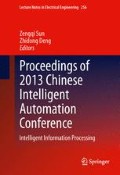Abstract
Dictionary learning has attracted growing intention for its prominent performance in many computer vision applications including facial expression recognition (FER). Discriminative K-SVD (D-KSVD) is one of conventional dictionary learning methods, which can effectively unify dictionary learning and classifier. However, the computation is huge when applying D-KSVD directly on Gabor features which has high dimension. To tackle this problem, we employ random projection on Gabor features and then put the reduced features into D-KSVD schema to obtain sparse representation and dictionary. To evaluate the performance, we implement the proposed method for FER on JAFFE database. We also employ support vector machine (SVM) on the sparse codes for FER. Experimental results show that the computation is reduced a lot with little performance lost.
Access this chapter
Tax calculation will be finalised at checkout
Purchases are for personal use only
References
Song M, Tao D, Huang X, Chen C, Bu J (2012) Three-dimensional face reconstruction from a single image by a coupled RBF network. IEEE Trans Image Process 21(5):2887–2897
Wright J, Yang A, Ganesh A, Sastry S, Ma Y (2009) Robust face recognition via sparse representation. IEEE Trans Pattern Anal Mach Intel 31:210–227
Cotter SF (2010) Sparse representation for accurate classification of corrupted and occluded facial expressions. ICASSP 838–841
Huang M, Wang Z, Ying Z (2010) A new method for facial expression recognition based on sparse representation plus LBP. CISP 4:1750–1754
Monaci G, Vandergheynst P, Sommer PT (2009) Learning bimodal structure in audio-visual data. IEEE Trans Neural Netw 20(12):1898–1910
Tian X, Tao D, Rui Y (2012) Sparse transfer learning for interactive video search reranking, ACM TOMCCAP 7665:269–276
Mairal J, Bach F, Ponce J et al. (2008) Discriminative learned dictionaries for local image analysis. CVPR 14(12):2091–2106
Protter M, Elad M (2009) Image sequence denoising via sparse and redundant representation. IEEE Trans Image Process 18(1):27–35
Zepeda J, Guillemot C, Kijak E (2011) Image compression using the iteration-tuned and aligned dictionary. ICASSP 1:739–796
Liu W, Song C, Wang Y (2012) Facial expression recognition based on discriminative dictionary learning. ICPR 1:1839–1842
Aharon M, Elad M, Bruckstein A (2006) K-SVD: an algorithm for designing over-complete dictionaries for sparse representation. IEEE Trans Signal Process 54(11):4311–4322
Pham D, Venkatesh S (2008) Joint learning and dictionary construction for pattern recognition. CVPR 1–8
Zhang Q, Li B (2010) Discriminative k-svd for dictionary learning in face recognition. CVPR 2691–2698
Majumdar A, Ward RK (2010) Robust classifier for data reduced via random projections. IEEE Trans Syst Man, Cybern, Part B: Cybernet 40:1359–1371
Sulić V, Perš J, Kristan M, Kovačič S (2010) Dimensionality reduction for distributed vision system using random projection. ICPR 31:380–383
Johnson WB, Lindenstrauss J (1984) Extensions of lipshitz mapping into hilbert space. In: Contemporary mathematics, conference in modern analysis and probability, vol 26, pp 189–206
Donoho DL (2006) Compressed sensing. IEEE Trans Inf Theory 52(4):1289–1306
Cai TT, Wang L (2011) Orthogonal matching pursuit sparse signal recovery with noise. IEEE Trans Inf Theory 57:4680–4688
Yu H, Bennamoun M (2006) 1D-PCA, 2D-PCA to n D-PCA. ICPR 4:181–184
Guan N, Tao D, Luo Z, Yuan B (2012) Online nonnegative matrix factorization with robust stochastic approximation. IEEE Trans Neural Netw Learn Syst 23(7):1087–1099
Guan N, Tao D, Luo Z, Yuan B (2012) NeNMF: An optimal gradient method for nonnegative matrix factorization. IEEE Trans Signal Process 60(6):2882–2898
Guan N, Tao D, Luo Z, Yuan B (2011) Non-negative patch alignment framework. IEEE Trans Neural Netw 22(8):1218–1230
Achlioptas D (2003) Database-friendly random projections. J Comput Syst Sci 66(4):671–687
Lin J, Gunopulos D (2003) Dimensionality reduction by random projection and latent semantic indexing. SDM
Lyons M, Akamatsu S (1998) Coding facial expressions with gabor wavelets. AFGR 200–205
Song M, Tao D, Liu Z, Li X, Zhou M (2010) Image ratio features for facial expression recognition application. IEEE Trans Syst, Man, Cybernet, Part B 40(3):779–788
Tan N, Huang L, Liu C (2008) Face recognition based on LBP and orthogonal rank-one tensor projections. ICPR
Tao D, Li X, Wu X, Stephen, Maybank J (2007) General tensor discriminant analysis and gabor features for gait recognition. IEEE Trans Pattern Anal Mach Intell 29(10):1700–1715
Acknowledgments
This paper is supported by the National Nature Science Foundation of China (No. 61271407), the Nature Science Foundation of Shandong Province (No. ZR2011FQ016) and the Fundamental Research Funds for the Central Universities (No. 13CX02096A).
Author information
Authors and Affiliations
Corresponding author
Editor information
Editors and Affiliations
Rights and permissions
Copyright information
© 2013 Springer-Verlag Berlin Heidelberg
About this paper
Cite this paper
Liu, W., Song, C., Wang, Y. (2013). Efficient Discriminative K-SVD for Facial Expression Recognition. In: Sun, Z., Deng, Z. (eds) Proceedings of 2013 Chinese Intelligent Automation Conference. Lecture Notes in Electrical Engineering, vol 256. Springer, Berlin, Heidelberg. https://doi.org/10.1007/978-3-642-38466-0_2
Download citation
DOI: https://doi.org/10.1007/978-3-642-38466-0_2
Published:
Publisher Name: Springer, Berlin, Heidelberg
Print ISBN: 978-3-642-38465-3
Online ISBN: 978-3-642-38466-0
eBook Packages: EngineeringEngineering (R0)

